CADILLAC XLR V 2006 1.G Owners Manual
Manufacturer: CADILLAC, Model Year: 2006, Model line: XLR V, Model: CADILLAC XLR V 2006 1.GPages: 456, PDF Size: 3.74 MB
Page 331 of 456
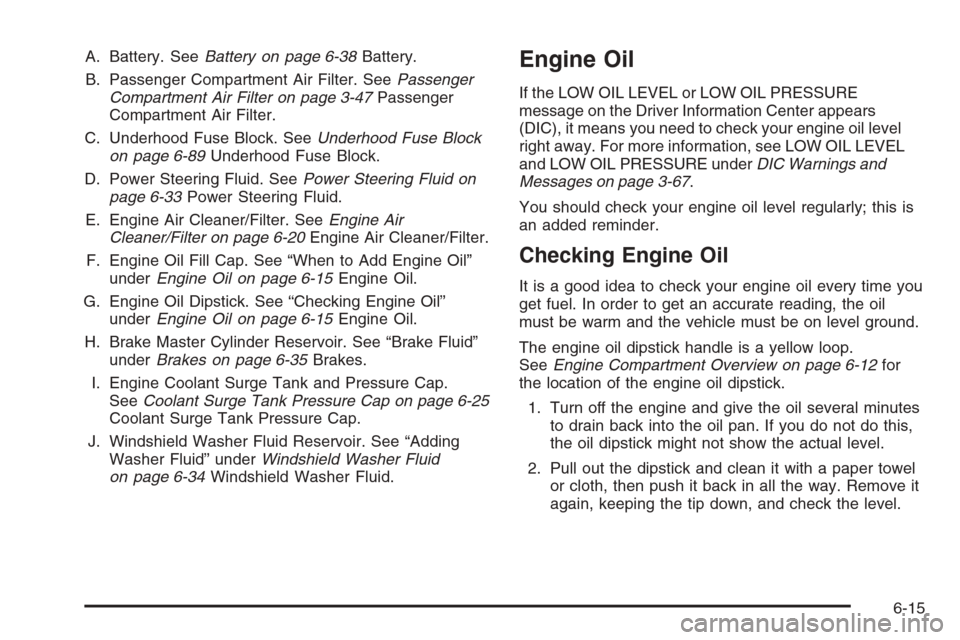
A. Battery. SeeBattery on page 6-38Battery.
B. Passenger Compartment Air Filter. SeePassenger
Compartment Air Filter on page 3-47Passenger
Compartment Air Filter.
C. Underhood Fuse Block. SeeUnderhood Fuse Block
on page 6-89Underhood Fuse Block.
D. Power Steering Fluid. SeePower Steering Fluid on
page 6-33Power Steering Fluid.
E. Engine Air Cleaner/Filter. SeeEngine Air
Cleaner/Filter on page 6-20Engine Air Cleaner/Filter.
F. Engine Oil Fill Cap. See “When to Add Engine Oil”
underEngine Oil on page 6-15Engine Oil.
G. Engine Oil Dipstick. See “Checking Engine Oil”
underEngine Oil on page 6-15Engine Oil.
H. Brake Master Cylinder Reservoir. See “Brake Fluid”
underBrakes on page 6-35Brakes.
I. Engine Coolant Surge Tank and Pressure Cap.
SeeCoolant Surge Tank Pressure Cap on page 6-25
Coolant Surge Tank Pressure Cap.
J. Windshield Washer Fluid Reservoir. See “Adding
Washer Fluid” underWindshield Washer Fluid
on page 6-34Windshield Washer Fluid.Engine Oil
If the LOW OIL LEVEL or LOW OIL PRESSURE
message on the Driver Information Center appears
(DIC), it means you need to check your engine oil level
right away. For more information, see LOW OIL LEVEL
and LOW OIL PRESSURE underDIC Warnings and
Messages on page 3-67.
You should check your engine oil level regularly; this is
an added reminder.
Checking Engine Oil
It is a good idea to check your engine oil every time you
get fuel. In order to get an accurate reading, the oil
must be warm and the vehicle must be on level ground.
The engine oil dipstick handle is a yellow loop.
SeeEngine Compartment Overview on page 6-12for
the location of the engine oil dipstick.
1. Turn off the engine and give the oil several minutes
to drain back into the oil pan. If you do not do this,
the oil dipstick might not show the actual level.
2. Pull out the dipstick and clean it with a paper towel
or cloth, then push it back in all the way. Remove it
again, keeping the tip down, and check the level.
6-15
Page 332 of 456
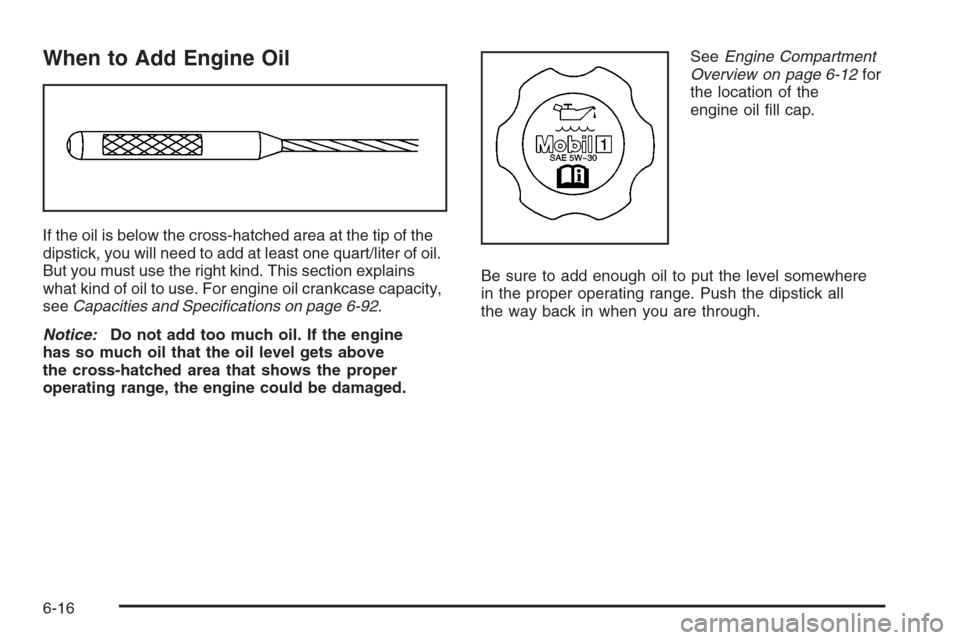
When to Add Engine Oil
If the oil is below the cross-hatched area at the tip of the
dipstick, you will need to add at least one quart/liter of oil.
But you must use the right kind. This section explains
what kind of oil to use. For engine oil crankcase capacity,
seeCapacities and Speci�cations on page 6-92.
Notice:Do not add too much oil. If the engine
has so much oil that the oil level gets above
the cross-hatched area that shows the proper
operating range, the engine could be damaged.SeeEngine Compartment
Overview on page 6-12for
the location of the
engine oil �ll cap.
Be sure to add enough oil to put the level somewhere
in the proper operating range. Push the dipstick all
the way back in when you are through.
6-16
Page 333 of 456

What Kind of Engine Oil to Use
Look for two things:
GM4718M
Your vehicle’s engine requires a special oil meeting
GM Standard GM4718M. Oils meeting this
standard may be identi�ed as synthetic. However,
not allsyntheticoils will meet this GM standard.
You should look for and use only an oil that meets
GM Standard GM4718M.Notice:If you use oils that do not have the
GM4718M Standard designation, you can cause
engine damage not covered by your warranty.
SAE 5W-30
As shown in the viscosity chart, SAE 5W-30 is best
for your vehicle.
These numbers on an oil container show its
viscosity, or thickness. Do not use other viscosity
oils such as SAE 20W-50.
Oils meeting these
requirements should also
have the starburst
symbol on the container.
This symbol indicates
that the oil has been
certi�ed by the American
Petroleum Institute (API).
You should look for this on the oil container, and
useonlythose oils that are identi�ed as meeting
GM Standard GM4718M and have the starburst
symbol on the front of the oil container.
6-17
Page 334 of 456
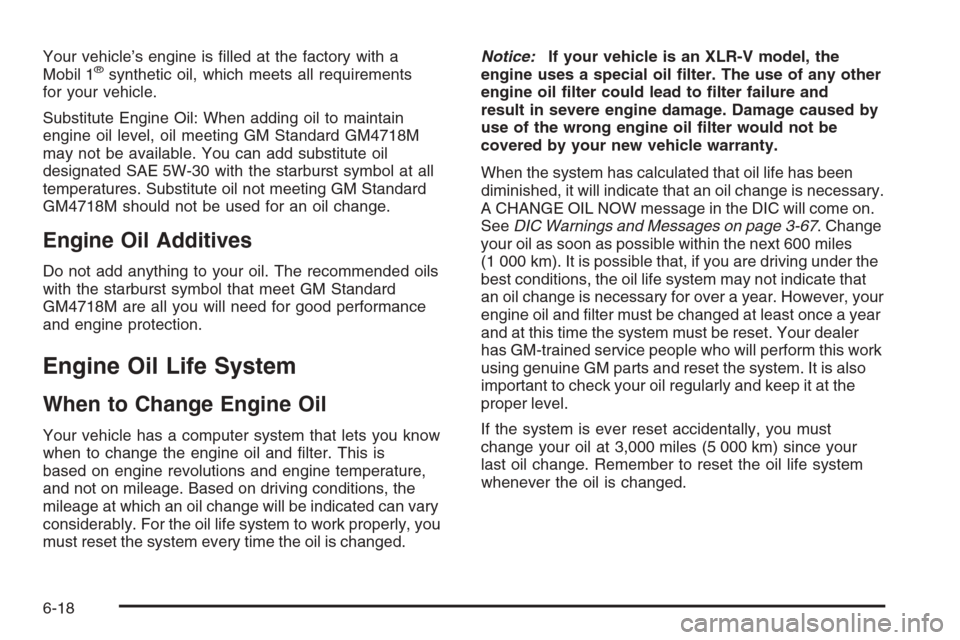
Your vehicle’s engine is �lled at the factory with a
Mobil 1®synthetic oil, which meets all requirements
for your vehicle.
Substitute Engine Oil: When adding oil to maintain
engine oil level, oil meeting GM Standard GM4718M
may not be available. You can add substitute oil
designated SAE 5W-30 with the starburst symbol at all
temperatures. Substitute oil not meeting GM Standard
GM4718M should not be used for an oil change.
Engine Oil Additives
Do not add anything to your oil. The recommended oils
with the starburst symbol that meet GM Standard
GM4718M are all you will need for good performance
and engine protection.
Engine Oil Life System
When to Change Engine Oil
Your vehicle has a computer system that lets you know
when to change the engine oil and �lter. This is
based on engine revolutions and engine temperature,
and not on mileage. Based on driving conditions, the
mileage at which an oil change will be indicated can vary
considerably. For the oil life system to work properly, you
must reset the system every time the oil is changed.Notice:If your vehicle is an XLR-V model, the
engine uses a special oil �lter. The use of any other
engine oil �lter could lead to �lter failure and
result in severe engine damage. Damage caused by
use of the wrong engine oil �lter would not be
covered by your new vehicle warranty.
When the system has calculated that oil life has been
diminished, it will indicate that an oil change is necessary.
A CHANGE OIL NOW message in the DIC will come on.
SeeDIC Warnings and Messages on page 3-67. Change
your oil as soon as possible within the next 600 miles
(1 000 km). It is possible that, if you are driving under the
best conditions, the oil life system may not indicate that
an oil change is necessary for over a year. However, your
engine oil and �lter must be changed at least once a year
and at this time the system must be reset. Your dealer
has GM-trained service people who will perform this work
using genuine GM parts and reset the system. It is also
important to check your oil regularly and keep it at the
proper level.
If the system is ever reset accidentally, you must
change your oil at 3,000 miles (5 000 km) since your
last oil change. Remember to reset the oil life system
whenever the oil is changed.
6-18
Page 335 of 456

How to Reset the Engine Oil Life
System and the Oil Life Indicator
The Engine Oil Life System calculates when to
change your engine oil and �lter based on vehicle use.
Anytime your oil is changed, reset the system so it
can calculate when the next oil change is required. If a
situation occurs where you change your oil prior to a
CHANGE OIL NOW message in the DIC being turned
on, reset the system.
After the oil has been changed, the CHANGE OIL NOW
message and the oil life indicator must be reset.
To reset the message use the following procedure:
1. Press the up or down arrow to scroll the DIC
to show OIL LIFE.
2. Once the XXX% ENGINE OIL LIFE menu item is
highlighted, press and hold the RESET button until
the percentage shows 100%.
If the percentage does not return to 100% or if
the CHANGE OIL NOW message comes back
on when you start your vehicle, the engine oil life
system has not reset. Repeat the procedure.
What to Do with Used Oil
Used engine oil contains certain elements that may be
unhealthy for your skin and could even cause cancer.
Do not let used oil stay on your skin for very long.
Clean your skin and nails with soap and water, or a
good hand cleaner. Wash or properly dispose of
clothing or rags containing used engine oil. See the
manufacturer’s warnings about the use and disposal
of oil products.
Used oil can be a threat to the environment. If you
change your own oil, be sure to drain all the oil from
the �lter before disposal. Never dispose of oil by putting
it in the trash, pouring it on the ground, into sewers,
or into streams or bodies of water. Instead, recycle it
by taking it to a place that collects used oil. If you
have a problem properly disposing of your used oil,
ask your dealer, a service station, or a local recycling
center for help.
6-19
Page 336 of 456

Engine Air Cleaner/Filter
SeeEngine Compartment Overview on page 6-12
for the location of the engine air cleaner/�lters.
When to Inspect the Engine
Air Cleaner/Filters
Inspect the air cleaner/�lters at the MaintenanceII
intervals and replace them at the �rst oil change
after each 50,000 mile (83 000 km) interval. See
Scheduled Maintenance on page 7-4for more
information. If you are driving in dusty/dirty conditions,
inspect the �lters at each engine oil change.
How to Inspect the Engine
Air Cleaner/Filters
To inspect the air cleaner/�lters, remove the �lters
from the vehicle and lightly shake the �lters to release
loose dust and dirt. If the �lters remain caked with
dirt, new �lters are required.To inspect or replace the �lters, do the following:
1. Flip the clasps on the top of the engine air
cleaner/�lter cover forward to unlatch the cover.
2. Lift the front of the cover at an angle and remove.
This is necessary due to the four tabs located on
the rear of the cover.
3. Remove the engine air cleaner/�lter element
and any loose debris that may be found in the
air cleaner base.
4. Inspect or replace the �lter.
5. Repeat the procedure for the second
air cleaner/�lter.
6-20
Page 337 of 456
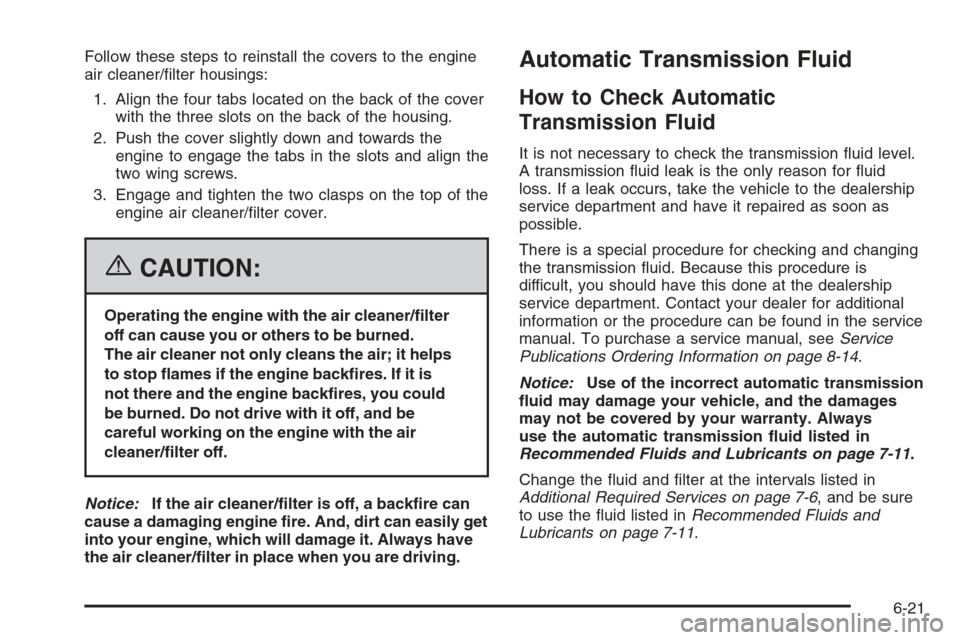
Follow these steps to reinstall the covers to the engine
air cleaner/�lter housings:
1. Align the four tabs located on the back of the cover
with the three slots on the back of the housing.
2. Push the cover slightly down and towards the
engine to engage the tabs in the slots and align the
two wing screws.
3. Engage and tighten the two clasps on the top of the
engine air cleaner/�lter cover.
{CAUTION:
Operating the engine with the air cleaner/�lter
off can cause you or others to be burned.
The air cleaner not only cleans the air; it helps
to stop �ames if the engine back�res. If it is
not there and the engine back�res, you could
be burned. Do not drive with it off, and be
careful working on the engine with the air
cleaner/�lter off.
Notice:If the air cleaner/�lter is off, a back�re can
cause a damaging engine �re. And, dirt can easily get
into your engine, which will damage it. Always have
the air cleaner/�lter in place when you are driving.
Automatic Transmission Fluid
How to Check Automatic
Transmission Fluid
It is not necessary to check the transmission �uid level.
A transmission �uid leak is the only reason for �uid
loss. If a leak occurs, take the vehicle to the dealership
service department and have it repaired as soon as
possible.
There is a special procedure for checking and changing
the transmission �uid. Because this procedure is
difficult, you should have this done at the dealership
service department. Contact your dealer for additional
information or the procedure can be found in the service
manual. To purchase a service manual, seeService
Publications Ordering Information on page 8-14.
Notice:Use of the incorrect automatic transmission
�uid may damage your vehicle, and the damages
may not be covered by your warranty. Always
use the automatic transmission �uid listed in
Recommended Fluids and Lubricants on page 7-11.
Change the �uid and �lter at the intervals listed in
Additional Required Services on page 7-6, and be sure
to use the �uid listed inRecommended Fluids and
Lubricants on page 7-11.
6-21
Page 338 of 456
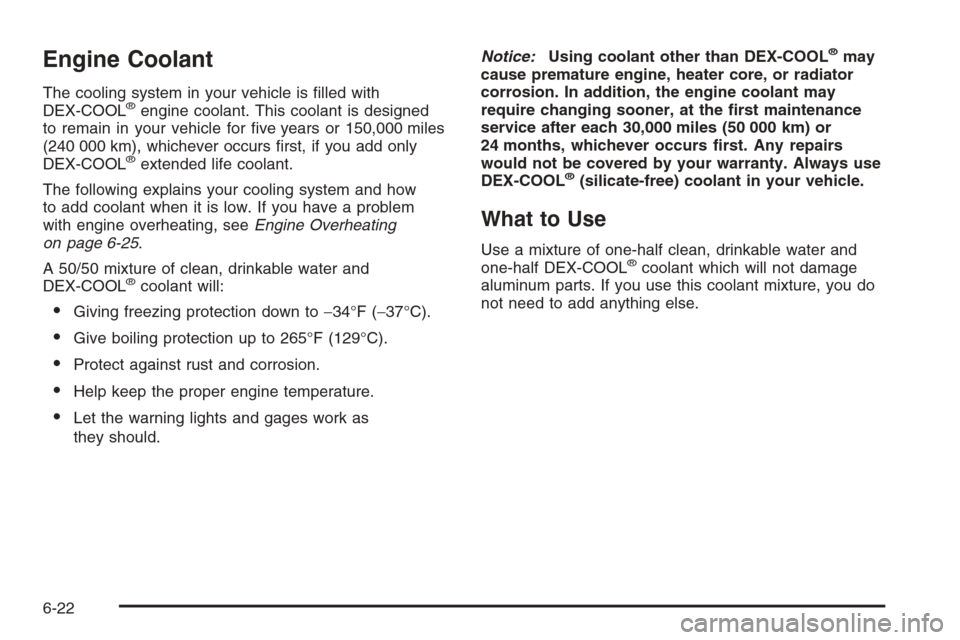
Engine Coolant
The cooling system in your vehicle is �lled with
DEX-COOL®engine coolant. This coolant is designed
to remain in your vehicle for �ve years or 150,000 miles
(240 000 km), whichever occurs �rst, if you add only
DEX-COOL
®extended life coolant.
The following explains your cooling system and how
to add coolant when it is low. If you have a problem
with engine overheating, seeEngine Overheating
on page 6-25.
A 50/50 mixture of clean, drinkable water and
DEX-COOL
®coolant will:
Giving freezing protection down to−34°F (−37°C).
Give boiling protection up to 265°F (129°C).
Protect against rust and corrosion.
Help keep the proper engine temperature.
Let the warning lights and gages work as
they should.Notice:Using coolant other than DEX-COOL
®may
cause premature engine, heater core, or radiator
corrosion. In addition, the engine coolant may
require changing sooner, at the �rst maintenance
service after each 30,000 miles (50 000 km) or
24 months, whichever occurs �rst. Any repairs
would not be covered by your warranty. Always use
DEX-COOL
®(silicate-free) coolant in your vehicle.
What to Use
Use a mixture of one-half clean, drinkable water and
one-half DEX-COOL®coolant which will not damage
aluminum parts. If you use this coolant mixture, you do
not need to add anything else.
6-22
Page 339 of 456
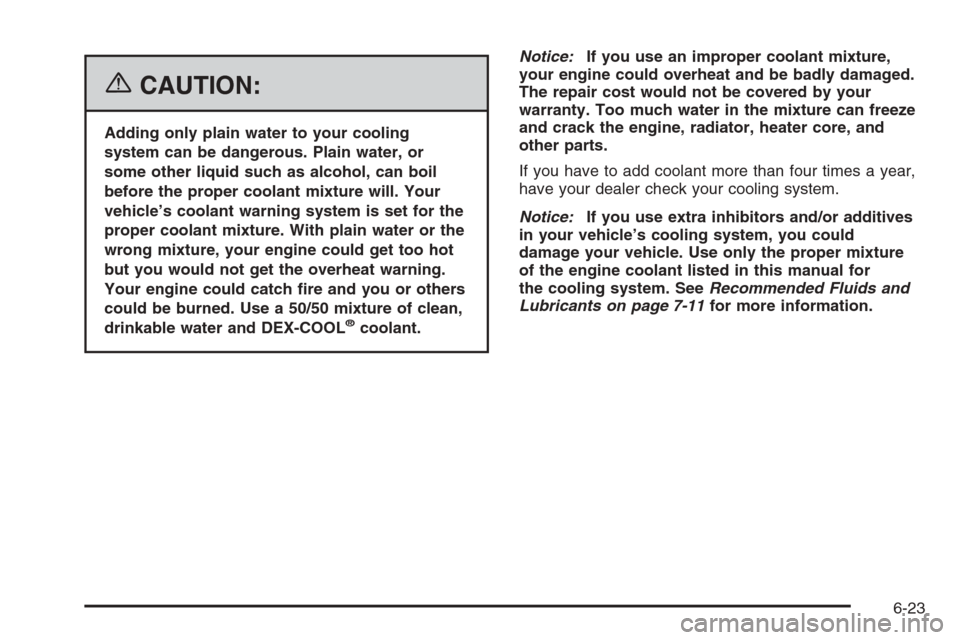
{CAUTION:
Adding only plain water to your cooling
system can be dangerous. Plain water, or
some other liquid such as alcohol, can boil
before the proper coolant mixture will. Your
vehicle’s coolant warning system is set for the
proper coolant mixture. With plain water or the
wrong mixture, your engine could get too hot
but you would not get the overheat warning.
Your engine could catch �re and you or others
could be burned. Use a 50/50 mixture of clean,
drinkable water and DEX-COOL
®coolant.Notice:If you use an improper coolant mixture,
your engine could overheat and be badly damaged.
The repair cost would not be covered by your
warranty. Too much water in the mixture can freeze
and crack the engine, radiator, heater core, and
other parts.
If you have to add coolant more than four times a year,
have your dealer check your cooling system.
Notice:If you use extra inhibitors and/or additives
in your vehicle’s cooling system, you could
damage your vehicle. Use only the proper mixture
of the engine coolant listed in this manual for
the cooling system. SeeRecommended Fluids and
Lubricants on page 7-11for more information.
6-23
Page 340 of 456
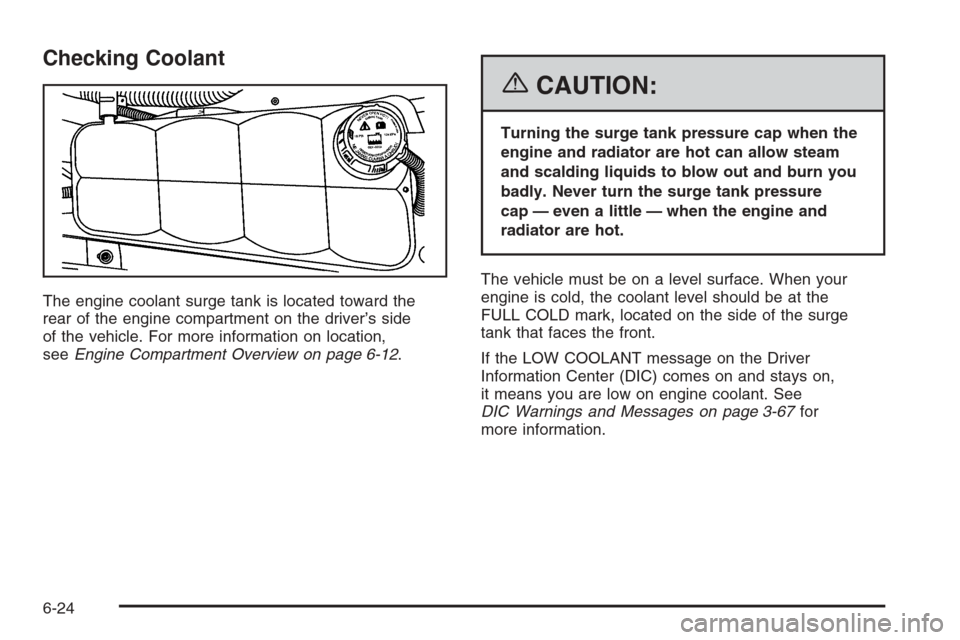
Checking Coolant
The engine coolant surge tank is located toward the
rear of the engine compartment on the driver’s side
of the vehicle. For more information on location,
seeEngine Compartment Overview on page 6-12.
{CAUTION:
Turning the surge tank pressure cap when the
engine and radiator are hot can allow steam
and scalding liquids to blow out and burn you
badly. Never turn the surge tank pressure
cap — even a little — when the engine and
radiator are hot.
The vehicle must be on a level surface. When your
engine is cold, the coolant level should be at the
FULL COLD mark, located on the side of the surge
tank that faces the front.
If the LOW COOLANT message on the Driver
Information Center (DIC) comes on and stays on,
it means you are low on engine coolant. See
DIC Warnings and Messages on page 3-67for
more information.
6-24